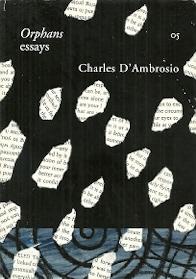Orphans: Essays, by Charles D’Ambrosio

Hold a copy of Orphans in your hand, and its singularity is apparent. With its small format and the slender ribbon bookmark, the book can easily be tucked into a pocket, kept close to be read anywhere. Published in 2005, Orphans has since become a cult classic. Originally a small-run edition from a Portland-based indie press, Clear Cut Press, the book quickly sold out and was never reprinted. And while you can still find copies online, you might pay a premium, but in my view, it’s worth it. D’Ambrosio is the author of two story collections, The Point and The Dead Fish Museum, and Orphans includes essays previously published in The Stranger, Nest, Harper’s, and The New Yorker, and take on a range of topics. A breaking news-variety stakeout by police and television crews. A fundamentalist haunted house in Texas. An eco-village outside Austin. A visit to an orphanage in Svirstroy, Russia. Each investigation applies a persistent questioning of language—especially language used to examine the public sphere—and a lonely and steadfast connection to place.
“Seattle, 1974” tracks the young writer’s youthful ambition and the nagging displacement of life in a provincial and isolated town. Seattle before the tech boom is a place known for a sitcom (Here Come the Brides), with wet weather and isolation and a singularity of things (“one dog a-barking, one car a-cranking”). Seattle—in fact the Northwest—doesn’t fit the dream:
Anyone born in geographical exile, anyone from the provinces, anyone for who the movements of culture feel rumored, anyone like this grows up anxiously aware that all the innovative and vital events in the world happen Back East, like way back, like probably France, but before expatriation can be accomplished in fact it is rehearsed and performed in the head. You make yourself clever and scoffing, ironic, deracinated, cold and quick to despise. You import your enthusiasms from the past, other languages, traditions . . . Pretty soon the word Paris takes on a numinous quality and you know you won’t be silent forever. Someday you’ll leave.
But in time Seattle wins out, and though the city becomes prosperous and hip, the vanished place remains inside the writer. This absence produces a yearning, one that’s probably familiar to anyone who’s seen a place change. If you’ve lived long enough, you can walk down a street you grew up on and all you see are absences, the buildings and streets razed to make way for the new, and the loss serves to make the place more your own.

This sense of dislocation runs throughout Orphans. In “Brick Wall,” all that remains of an uncle’s Chicago bar is the wall of the title. The essay is a rumination on change, and the brick used to build Big Shoulders Chicago describes time, destruction and loss. In “Modular Homes,” D’Ambrosio tours the staged interiors of model properties, a “tableau vivant” of plastic food and ersatz framed photos. “All these houses,” he says, “are waiting for a future to come and haunt them.” The collection’s title essay ventures into similar territory. D’Ambrosio visits an orphanage outside St. Petersburg, and the children he meets there are fixed in time and place, living apart from their history and the world beyond the orphanage. The life that lies ahead is unreal and largely abstract, as is the past, which for many of the children is so thin as to seem mythological. They collect and trade throwaways, old batteries and such, objects which in this institutional setting carry more weight than money: “The absence of ‘real’ money, fiat money, is essentially the absence of a future.”
There are other questions in Orphans, such as, how is it you can go to a place where for centuries whale has been eaten, but there’s none to be had? Or, what do the tableaus of death in a fundamentalist haunted house achieve in a morally confusing world? Or, how does a group of orphaned children find meaning in a world premised on loss? Sometimes the answer isn’t found in words:
Maybe more than the building itself, the land around the orphanage and the elaborate network of footpaths create for the kids a sense of place. There are trails through the birch and pine, across fields where, every spring, the kids burn leaves and work the ash into the soil and plant potatoes, trails that lead to the river, to the school, to the village, to ponds and creeks and springs flowing up from beneath the ground with cool, drinkable water, trails that are a story in themselves, worn by wandering feet over fifty years, worn by joy and hope and habit and need, trails like a sentence spoken, each a whisper about the surrounding world, a dialogue with doubt or desire that’s ultimately answered by a destination.
In showing this world, D’Ambrosio applies what he calls aesthetic pressure, and the result is a singular connection to place, one that undoes the familiar meaning of the word orphans. “The difference between the truth and a cliché is the difference between what we really know and what we’ve all heard about,” he says. Answers don’t always provide truth, but aesthetic pressure does. It brings us into contact with meaning—or to use the author’s infinitely more apt words, “the rich supple instrumentation of language that makes it an encounter with reality.”
Read more about the book, and the author, here.
—Lauren Alwan

